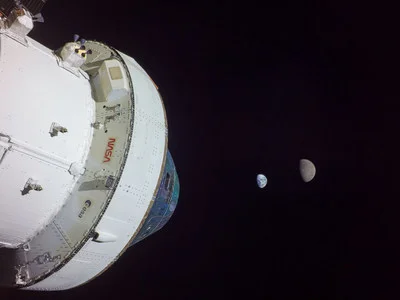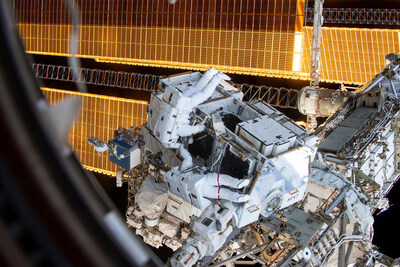NASA Sets Coverage of Orion's Historic Moon Mission Return, Splashdown
WASHINGTON, Dec. 2, 2022 /PRNewswire/ — NASA will provide live coverage of the Artemis I uncrewed Orion spacecraft’s return flyby of the Moon on Monday, Dec. 5, as well as its return to Earth on Sunday, Dec. 11.
The agency also will host several briefings to discuss the upcoming activities from Johnson Space Center in Houston. NASA will provide live coverage on NASA Television, the agency’s website, and the NASA app.
Orion has begun its return trek toward Earth, completing a burn Dec. 1, to exit a lunar orbit thousands of miles beyond the Moon, where engineers have been testing systems to improve understanding of the spacecraft before future missions with astronauts.
Return lunar flyby coverage will begin at 9 a.m. EST Monday, Dec. 5. The return powered flyby burn, in which the spacecraft will harness the Moon’s gravity and accelerate back toward Earth, is expected at 11:43 a.m. The spacecraft is expected to fly about 79 miles above the lunar surface at 11:42 a.m., just before the burn.
U.S. media wishing to join in the news conferences in person must request credentials from the Johnson newsroom no later than 1 p.m. on the day of each briefing at 281-483-5111 or jsccommu@mail.nasa.gov. Media interested in participating by phone must also contact the Johnson newsroom no later than one hour before the start of the briefings.
Live coverage as Mission Control, Houston, monitors the spacecraft’s entry, descent, and splashdown off the coast of San Diego will begin at 11 a.m. Sunday, Dec. 11. Splashdown is expected at 12:40 p.m., after which the exploration ground systems recovery team from NASA’s Kennedy Space Center in Florida, working with the U.S. Navy, will recover the spacecraft.
NASA also is hosting a STEM event in collaboration with the San Diego Air and Space Museum at 9 a.m. PST Sunday, Dec. 11, for students and families to learn about Orion and the science, technology, engineering, and math that ensures the success of the agency’s missions. Participants will be able to watch a live stream of the splashdown, participate in STEM hands on activities, and hear from NASA experts and Department of Education Deputy Secretary Cindy Marten.
https://sandiegoairandspace.org/Following the lunar flyby Dec. 5, NASA will host a 5 p.m. news conference at Johnson.
Participants will include:
- Mike Sarafin, Artemis mission manager, NASA Headquarters
- Judd Frieling, flight director, NASA Johnson
- Debbie Korth, Orion Program deputy manager, NASA Johnson
- Melissa Jones, landing and recovery director, NASA Kennedy Space Center
The agency also will hold a 5 p.m. Thursday, Dec. 8, news conference to preview Orion’s entry through Earth’s atmosphere, descent, and splashdown in the Pacific Ocean off the coast of San Diego.
Participants will include:
- Mike Sarafin, Artemis mission manager, NASA Headquarters
- Judd Frieling, flight director, Johnson
- Howard Hu, manager, Orion Program, NASA Johnson
- Melissa Jones, landing and recovery director, NASA Kennedy
A news conference also will be held after splashdown, about 3:30 p.m. Dec. 11.
Participants will include:
- Bill Nelson, NASA administrator
- Jim Free, NASA associate administrator for the Exploration System Development Mission Directorate, NASA Headquarters
- Howard Hu, Orion Program manager, Johnson
- Emily Nelson, chief flight director, Johnson
- Melissa Jones, recovery director, Kennedy
Following a successful launch on NASA’s Space Launch System rocket, Artemis I is testing the Orion spacecraft on a rigorous mission in the extreme environment of deep space around the Moon before flying astronauts on Artemis II in 2024. Artemis includes a series of increasingly complex missions that will enable human exploration at the Moon where the agency will prepare for future missions with crew to Mars.
Learn more about the Artemis I flight test at:
https://www.nasa.gov/artemis-1
![]() View original content to download multimedia:https://www.prnewswire.com/news-releases/nasa-sets-coverage-of-orions-historic-moon-mission-return-splashdown-301692908.html
View original content to download multimedia:https://www.prnewswire.com/news-releases/nasa-sets-coverage-of-orions-historic-moon-mission-return-splashdown-301692908.html
SOURCE NASA





 Private Internet Access gives you unparalleled access to thousands
of next-gen servers in over 83 countries and each US state. Your
VPN experience will always be fast, smooth, and reliable.
Private Internet Access gives you unparalleled access to thousands
of next-gen servers in over 83 countries and each US state. Your
VPN experience will always be fast, smooth, and reliable.
